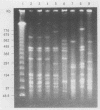Abstract
Because of the ubiquity of Legionella isolates in aquatic habitats, epidemiologic evaluation of Legionella pneumophila strains is important in the investigation and subsequent control of nosocomial outbreaks of legionellosis. In this study, ribotyping and restriction enzyme analysis by pulsed-field gel electrophoresis (PFGE) were used to compare isolates of L. pneumophila obtained from patients and the environment during a nosocomial outbreak with unrelated control strains. Restriction enzyme analysis by PFGE resolved 14 different patterns among the L. pneumophila serogroup 1 and L. pneumophila serogroup 6 isolates involved in the study. Two of the patterns were observed in the three L. pneumophila serogroup 6 isolates from patients with confirmed nosocomial infections and environmental isolates from the potable water supply, which was, therefore, believed to be the source of the patients' infections. Three more patterns that were not present in isolates from patients with legionellosis were seen in isolates from the hospital environment, demonstrating the presence of multiple strains in the hospital environment. In the outbreak, one distinct pattern occurred among the L. pneumophila serogroup 1 isolates from patients with nosocomial infections, suggesting a common source; however, the source could not be determined. By comparison, ribotyping generated five patterns. However, some control strains of both L. pneumophila serogroups 1 and 6 possessed the same ribotypes as were present in the outbreak isolates. Both techniques were used successfully to subtype the isolates obtained during the investigation of the outbreak. Furthermore, restriction enzyme analysis by PFGE was useful for subdividing ribotypes and for distinguishing strains involved in the outbreak from epidemiologically unrelated strains.
Full text
PDF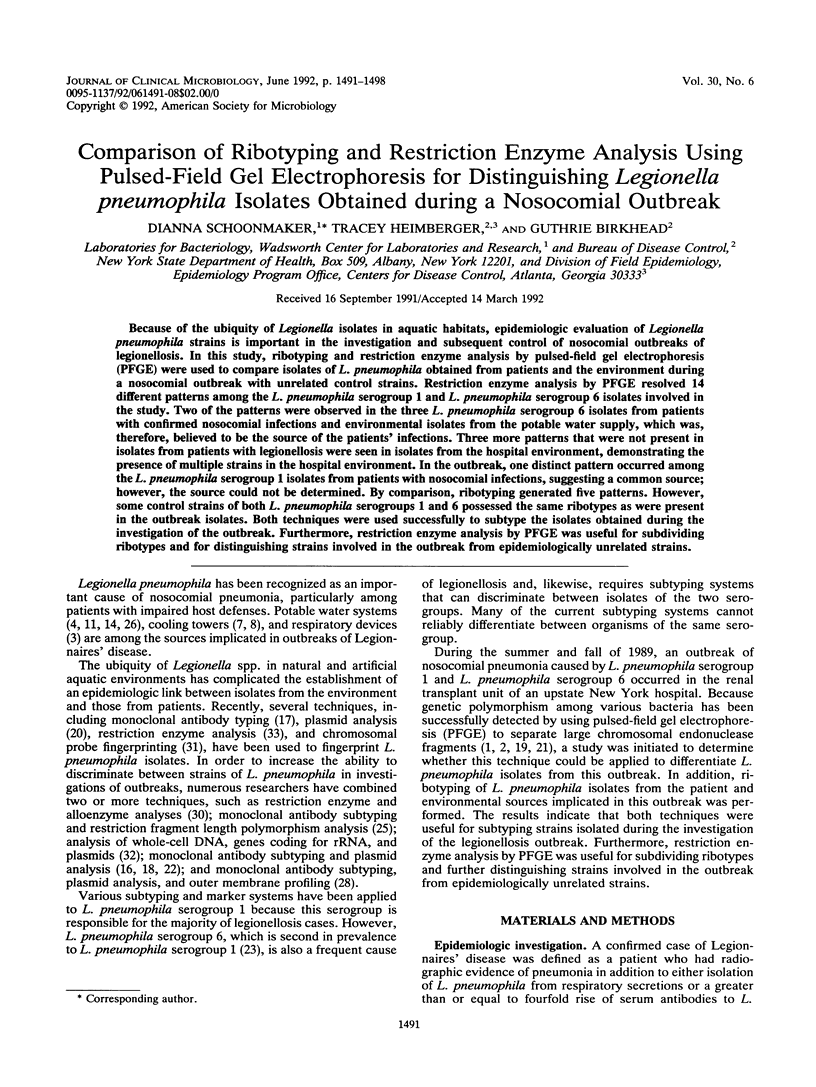
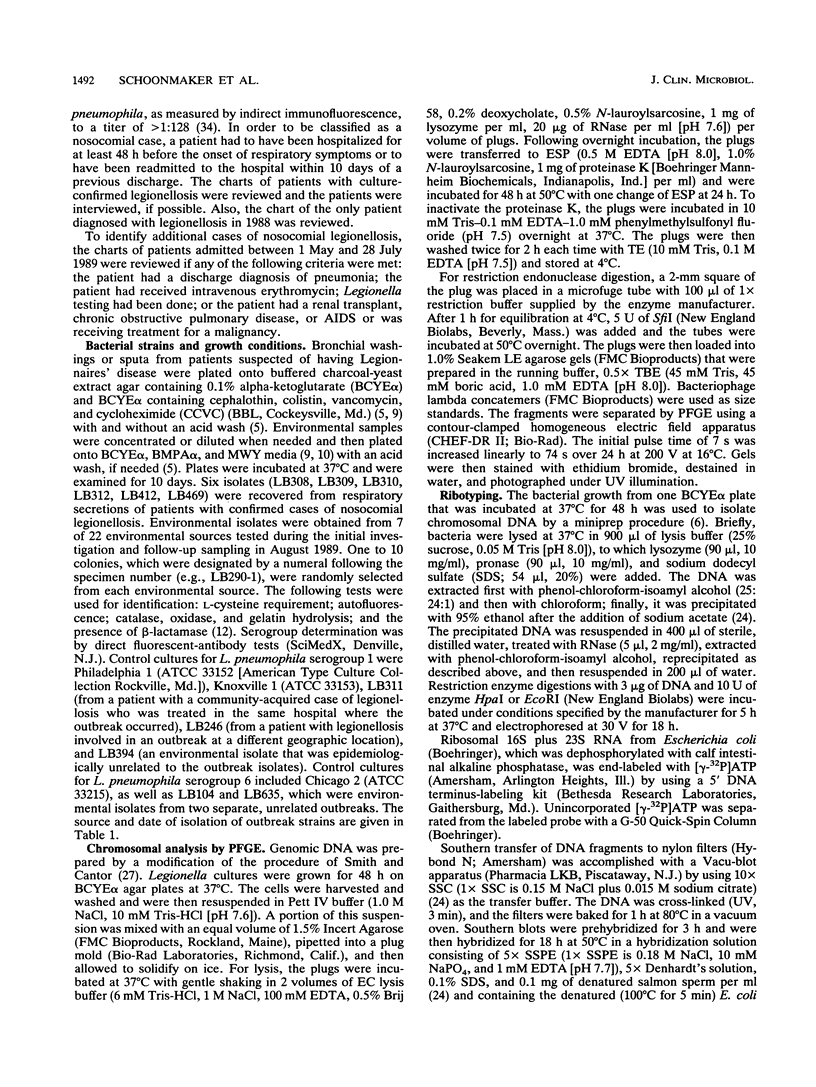
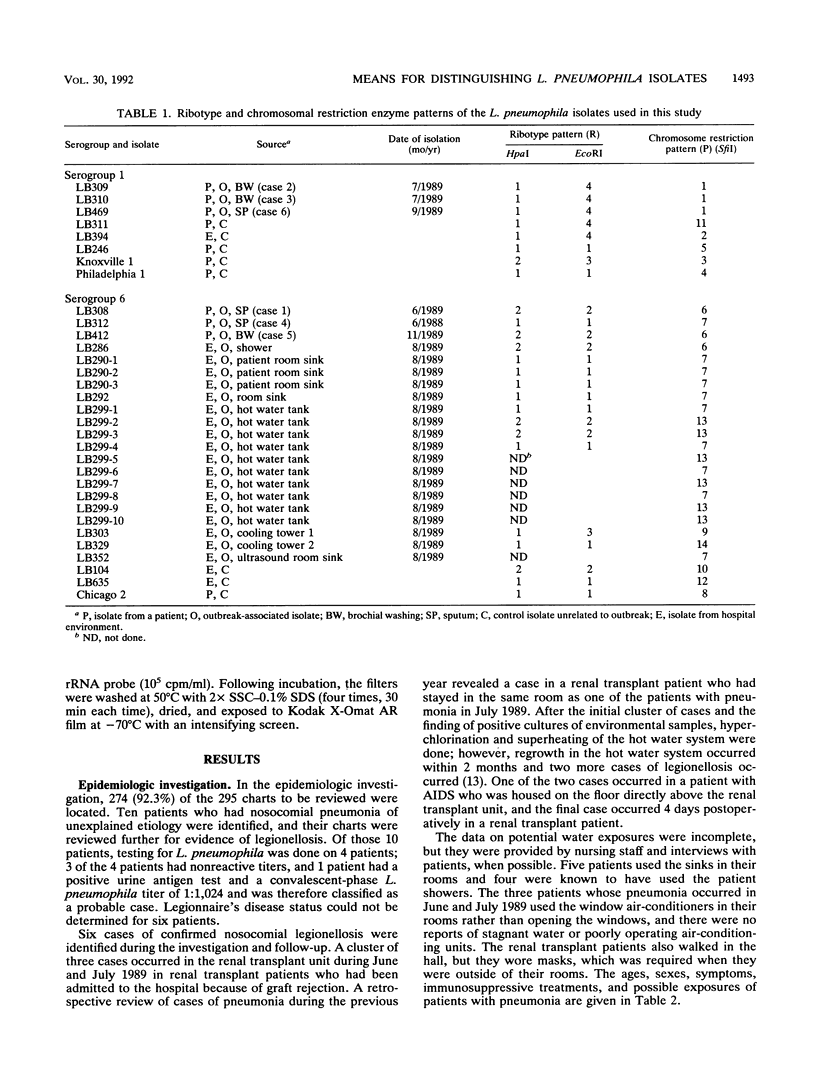
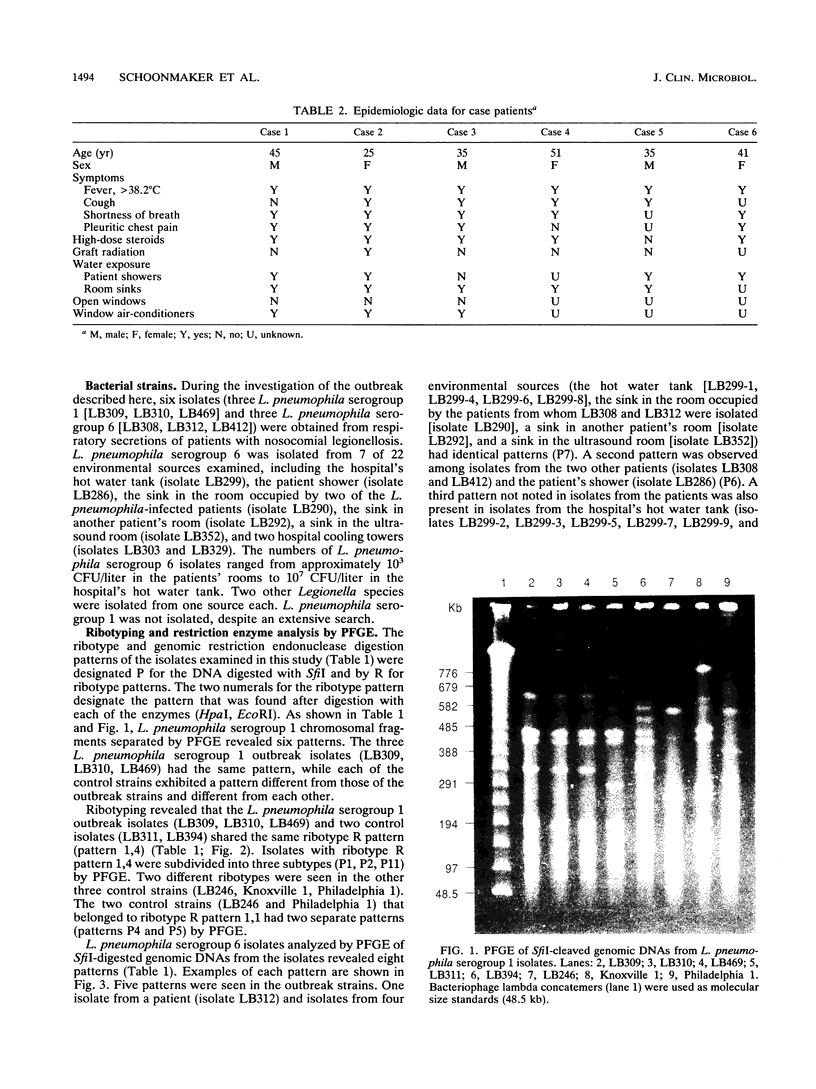
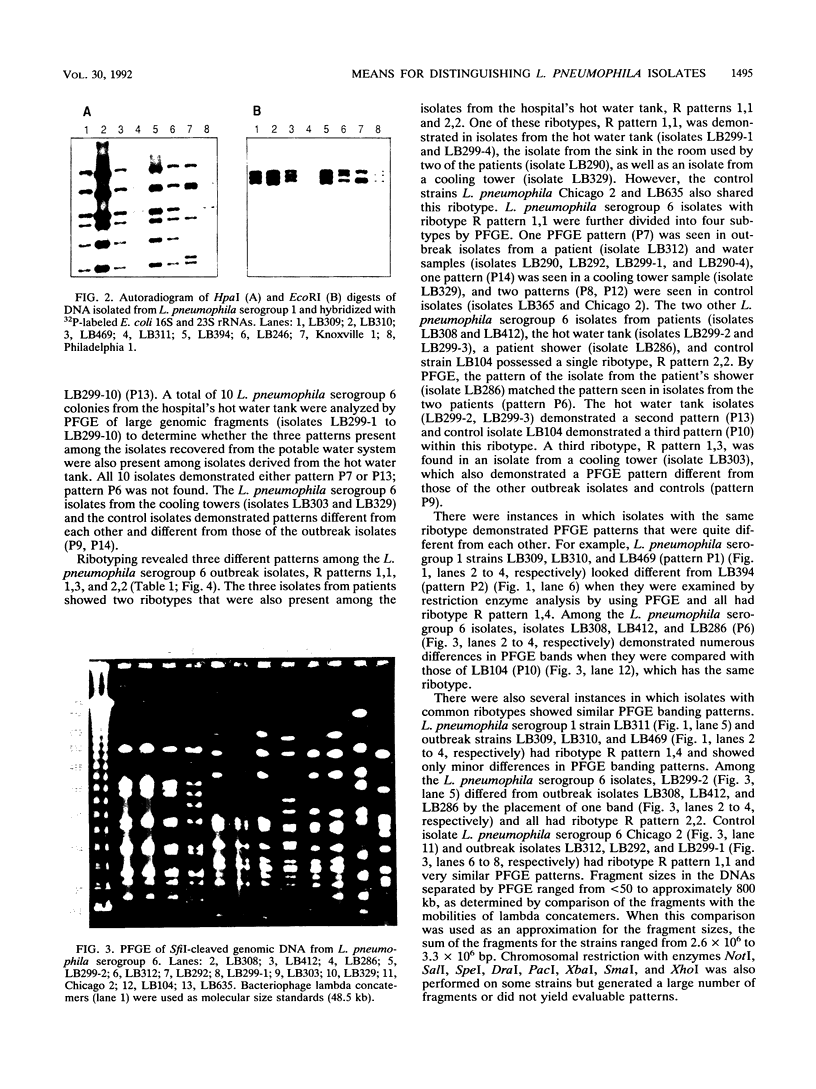
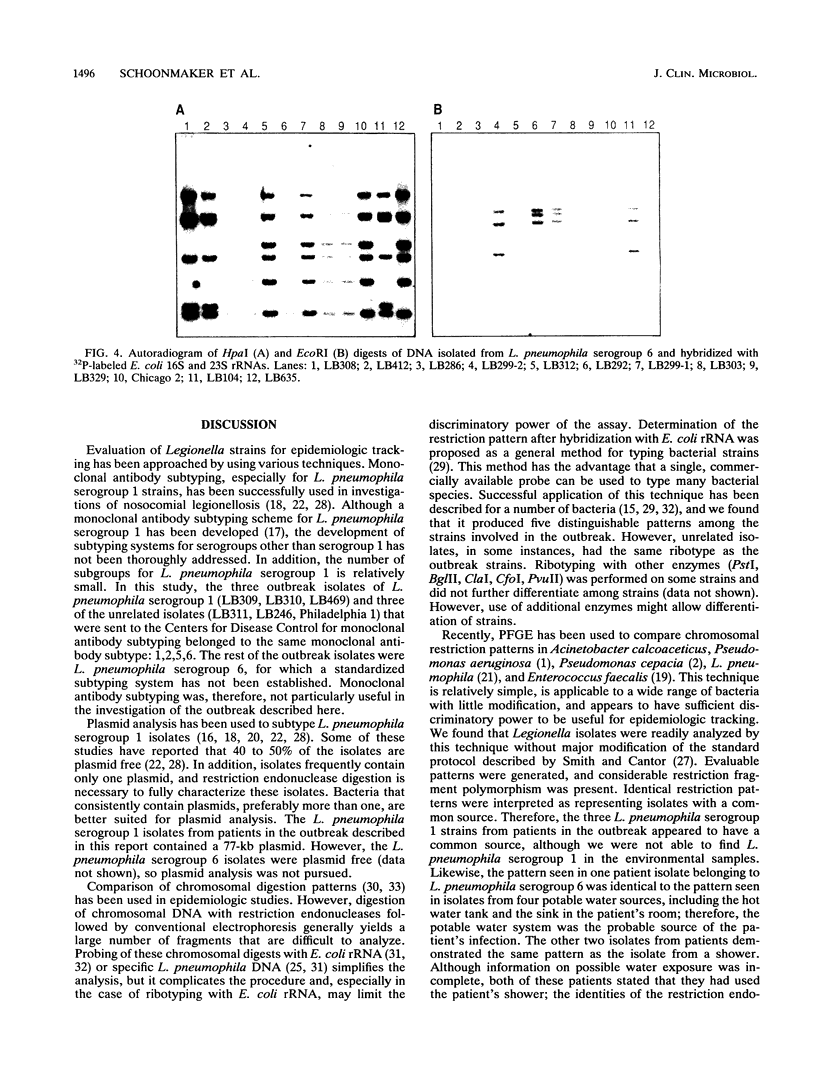
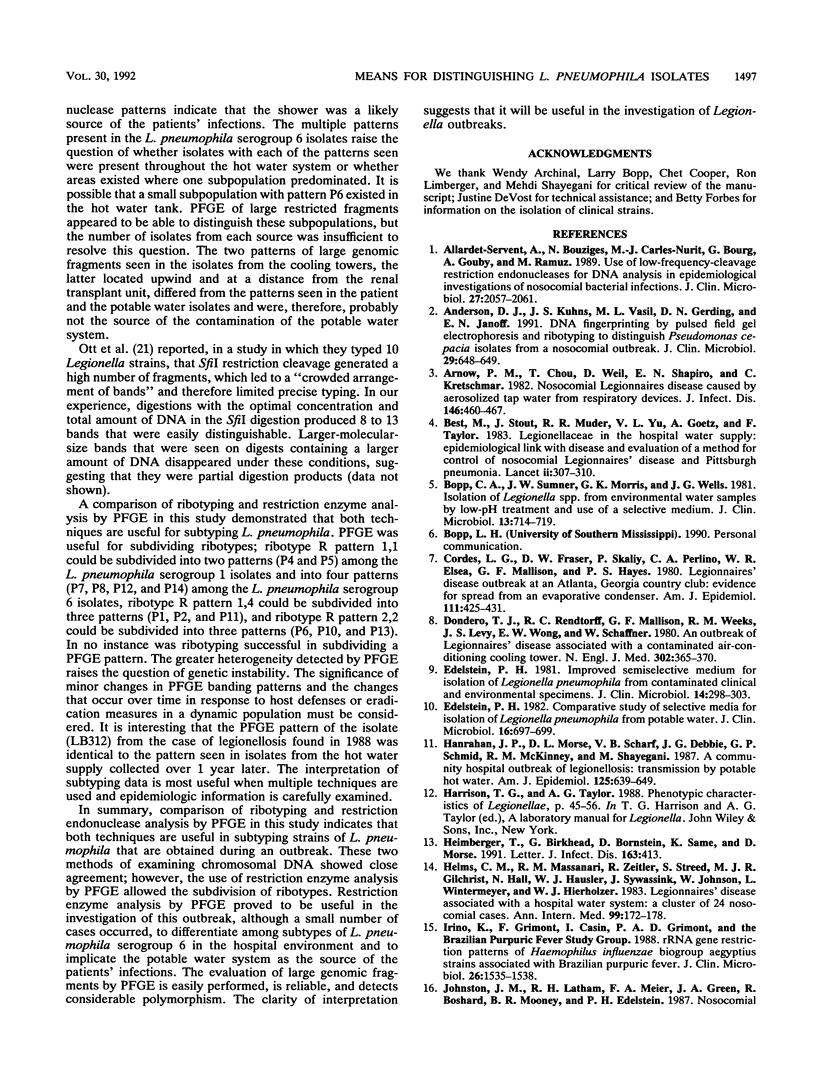
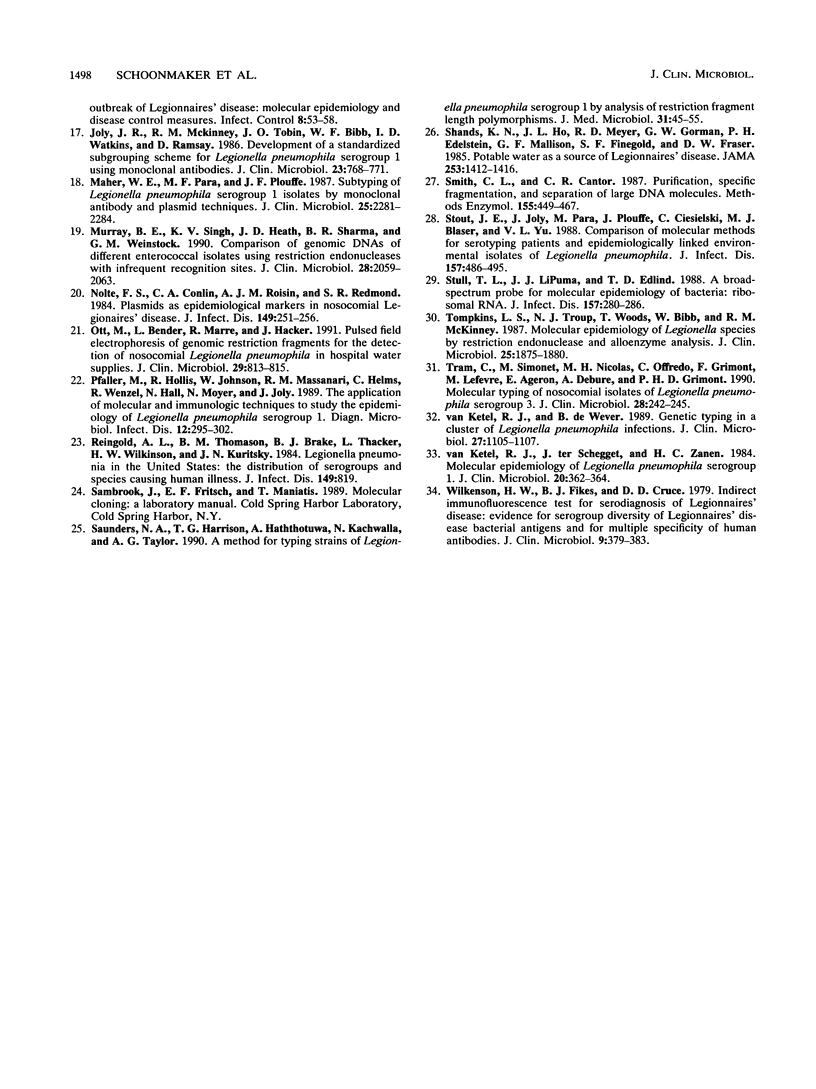
Images in this article
Selected References
These references are in PubMed. This may not be the complete list of references from this article.
- Allardet-Servent A., Bouziges N., Carles-Nurit M. J., Bourg G., Gouby A., Ramuz M. Use of low-frequency-cleavage restriction endonucleases for DNA analysis in epidemiological investigations of nosocomial bacterial infections. J Clin Microbiol. 1989 Sep;27(9):2057–2061. doi: 10.1128/jcm.27.9.2057-2061.1989. [DOI] [PMC free article] [PubMed] [Google Scholar]
- Anderson D. J., Kuhns J. S., Vasil M. L., Gerding D. N., Janoff E. N. DNA fingerprinting by pulsed field gel electrophoresis and ribotyping to distinguish Pseudomonas cepacia isolates from a nosocomial outbreak. J Clin Microbiol. 1991 Mar;29(3):648–649. doi: 10.1128/jcm.29.3.648-649.1991. [DOI] [PMC free article] [PubMed] [Google Scholar]
- Arnow P. M., Chou T., Weil D., Shapiro E. N., Kretzschmar C. Nosocomial Legionnaires' disease caused by aerosolized tap water from respiratory devices. J Infect Dis. 1982 Oct;146(4):460–467. doi: 10.1093/infdis/146.4.460. [DOI] [PubMed] [Google Scholar]
- Best M., Yu V. L., Stout J., Goetz A., Muder R. R., Taylor F. Legionellaceae in the hospital water-supply. Epidemiological link with disease and evaluation of a method for control of nosocomial legionnaires' disease and Pittsburgh pneumonia. Lancet. 1983 Aug 6;2(8345):307–310. doi: 10.1016/s0140-6736(83)90290-8. [DOI] [PubMed] [Google Scholar]
- Bopp C. A., Sumner J. W., Morris G. K., Wells J. G. Isolation of Legionella spp. from environmental water samples by low-pH treatment and use of a selective medium. J Clin Microbiol. 1981 Apr;13(4):714–719. doi: 10.1128/jcm.13.4.714-719.1981. [DOI] [PMC free article] [PubMed] [Google Scholar]
- Cordes L. G., Fraser D. W., Skaliy P., Perlino C. A., Elsea W. R., Mallison G. F., Hayes P. S. Legionnaires' disease outbreak at an Atlanta, Georgia, Country Club: evidence for spread from an evaporative condenser. Am J Epidemiol. 1980 Apr;111(4):425–431. doi: 10.1093/oxfordjournals.aje.a112917. [DOI] [PubMed] [Google Scholar]
- Dondero T. J., Jr, Rendtorff R. C., Mallison G. F., Weeks R. M., Levy J. S., Wong E. W., Schaffner W. An outbreak of Legionnaires' disease associated with a contaminated air-conditioning cooling tower. N Engl J Med. 1980 Feb 14;302(7):365–370. doi: 10.1056/NEJM198002143020703. [DOI] [PubMed] [Google Scholar]
- Edelstein P. H. Comparative study of selective media for isolation of Legionella pneumophila from potable water. J Clin Microbiol. 1982 Oct;16(4):697–699. doi: 10.1128/jcm.16.4.697-699.1982. [DOI] [PMC free article] [PubMed] [Google Scholar]
- Edelstein P. H. Improved semiselective medium for isolation of Legionella pneumophila from contaminated clinical and environmental specimens. J Clin Microbiol. 1981 Sep;14(3):298–303. doi: 10.1128/jcm.14.3.298-303.1981. [DOI] [PMC free article] [PubMed] [Google Scholar]
- Hanrahan J. P., Morse D. L., Scharf V. B., Debbie J. G., Schmid G. P., McKinney R. M., Shayegani M. A community hospital outbreak of legionellosis. Transmission by potable hot water. Am J Epidemiol. 1987 Apr;125(4):639–649. doi: 10.1093/oxfordjournals.aje.a114577. [DOI] [PubMed] [Google Scholar]
- Heimberger T., Birkhead G., Bornstein D., Same K., Morse D. Control of nosocomial Legionnaires' disease through hot water flushing and supplemental chlorination of potable water. J Infect Dis. 1991 Feb;163(2):413–413. doi: 10.1093/infdis/163.2.413. [DOI] [PubMed] [Google Scholar]
- Helms C. M., Massanari R. M., Zeitler R., Streed S., Gilchrist M. J., Hall N., Hausler W. J., Jr, Sywassink J., Johnson W., Wintermeyer L. Legionnaires' disease associated with a hospital water system: a cluster of 24 nosocomial cases. Ann Intern Med. 1983 Aug;99(2):172–178. doi: 10.7326/0003-4819-99-2-172. [DOI] [PubMed] [Google Scholar]
- Irino K., Grimont F., Casin I., Grimont P. A. rRNA gene restriction patterns of Haemophilus influenzae biogroup aegyptius strains associated with Brazilian purpuric fever. J Clin Microbiol. 1988 Aug;26(8):1535–1538. doi: 10.1128/jcm.26.8.1535-1538.1988. [DOI] [PMC free article] [PubMed] [Google Scholar]
- Joly J. R., McKinney R. M., Tobin J. O., Bibb W. F., Watkins I. D., Ramsay D. Development of a standardized subgrouping scheme for Legionella pneumophila serogroup 1 using monoclonal antibodies. J Clin Microbiol. 1986 Apr;23(4):768–771. doi: 10.1128/jcm.23.4.768-771.1986. [DOI] [PMC free article] [PubMed] [Google Scholar]
- Maher W. E., Para M. F., Plouffe J. F. Subtyping of Legionella pneumophila serogroup 1 isolates by monoclonal antibody and plasmid techniques. J Clin Microbiol. 1987 Dec;25(12):2281–2284. doi: 10.1128/jcm.25.12.2281-2284.1987. [DOI] [PMC free article] [PubMed] [Google Scholar]
- Murray B. E., Singh K. V., Heath J. D., Sharma B. R., Weinstock G. M. Comparison of genomic DNAs of different enterococcal isolates using restriction endonucleases with infrequent recognition sites. J Clin Microbiol. 1990 Sep;28(9):2059–2063. doi: 10.1128/jcm.28.9.2059-2063.1990. [DOI] [PMC free article] [PubMed] [Google Scholar]
- Nolte F. S., Conlin C. A., Roisin A. J., Redmond S. R. Plasmids as epidemiological markers in nosocomial Legionnaires' disease. J Infect Dis. 1984 Feb;149(2):251–256. doi: 10.1093/infdis/149.2.251. [DOI] [PubMed] [Google Scholar]
- Ott M., Bender L., Marre R., Hacker J. Pulsed field electrophoresis of genomic restriction fragments for the detection of nosocomial Legionella pneumophila in hospital water supplies. J Clin Microbiol. 1991 Apr;29(4):813–815. doi: 10.1128/jcm.29.4.813-815.1991. [DOI] [PMC free article] [PubMed] [Google Scholar]
- Pfaller M., Hollis R., Johnson W., Massanari R. M., Helms C., Wenzel R., Hall N., Moyer N., Joly J. The application of molecular and immunologic techniques to study the epidemiology of Legionella pneumophila serogroup 1. Diagn Microbiol Infect Dis. 1989 Jul-Aug;12(4):295–302. doi: 10.1016/0732-8893(89)90093-x. [DOI] [PubMed] [Google Scholar]
- Reingold A. L., Thomason B. M., Brake B. J., Thacker L., Wilkinson H. W., Kuritsky J. N. Legionella pneumonia in the United States: the distribution of serogroups and species causing human illness. J Infect Dis. 1984 May;149(5):819–819. doi: 10.1093/infdis/149.5.819. [DOI] [PubMed] [Google Scholar]
- Saunders N. A., Harrison T. G., Haththotuwa A., Kachwalla N., Taylor A. G. A method for typing strains of Legionella pneumophila serogroup 1 by analysis of restriction fragment length polymorphisms. J Med Microbiol. 1990 Jan;31(1):45–55. doi: 10.1099/00222615-31-1-45. [DOI] [PubMed] [Google Scholar]
- Shands K. N., Ho J. L., Meyer R. D., Gorman G. W., Edelstein P. H., Mallison G. F., Finegold S. M., Fraser D. W. Potable water as a source of Legionnaires' disease. JAMA. 1985 Mar 8;253(10):1412–1416. [PubMed] [Google Scholar]
- Smith C. L., Cantor C. R. Purification, specific fragmentation, and separation of large DNA molecules. Methods Enzymol. 1987;155:449–467. doi: 10.1016/0076-6879(87)55030-3. [DOI] [PubMed] [Google Scholar]
- Stout J. E., Joly J., Para M., Plouffe J., Ciesielski C., Blaser M. J., Yu V. L. Comparison of molecular methods for subtyping patients and epidemiologically linked environmental isolates of Legionella pneumophila. J Infect Dis. 1988 Mar;157(3):486–495. doi: 10.1093/infdis/157.3.486. [DOI] [PubMed] [Google Scholar]
- Stull T. L., LiPuma J. J., Edlind T. D. A broad-spectrum probe for molecular epidemiology of bacteria: ribosomal RNA. J Infect Dis. 1988 Feb;157(2):280–286. doi: 10.1093/infdis/157.2.280. [DOI] [PubMed] [Google Scholar]
- Tompkins L. S., Troup N. J., Woods T., Bibb W., McKinney R. M. Molecular epidemiology of Legionella species by restriction endonuclease and alloenzyme analysis. J Clin Microbiol. 1987 Oct;25(10):1875–1880. doi: 10.1128/jcm.25.10.1875-1880.1987. [DOI] [PMC free article] [PubMed] [Google Scholar]
- Tram C., Simonet M., Nicolas M. H., Offredo C., Grimont F., Lefevre M., Ageron E., Debure A., Grimont P. A. Molecular typing of nosocomial isolates of Legionella pneumophila serogroup 3. J Clin Microbiol. 1990 Feb;28(2):242–245. doi: 10.1128/jcm.28.2.242-245.1990. [DOI] [PMC free article] [PubMed] [Google Scholar]
- Wilkinson H. W., Fikes B. J., Cruce D. D. Indirect immunofluorescence test for serodiagnosis of Legionnaires disease: evidence for serogroup diversity of Legionnaires disease bacterial antigens and for multiple specificity of human antibodies. J Clin Microbiol. 1979 Mar;9(3):379–383. doi: 10.1128/jcm.9.3.379-383.1979. [DOI] [PMC free article] [PubMed] [Google Scholar]
- van Ketel R. J., de Wever B. Genetic typing in a cluster of Legionella pneumophila infections. J Clin Microbiol. 1989 May;27(5):1105–1107. doi: 10.1128/jcm.27.5.1105-1107.1989. [DOI] [PMC free article] [PubMed] [Google Scholar]
- van Ketel R. J., ter Schegget J., Zanen H. C. Molecular epidemiology of Legionella pneumophila serogroup 1. J Clin Microbiol. 1984 Sep;20(3):362–364. doi: 10.1128/jcm.20.3.362-364.1984. [DOI] [PMC free article] [PubMed] [Google Scholar]



